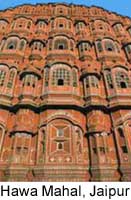|

|
States
Union Territories
|

|
| |
 Rajasthan is a state in the northwest of India. It is the second largest state in the country. Rajasthan means "the land of the rajahs (or kings)". It was also called Rajputana, "the country of the Rajputs" (a group of clans). The state has a long border with Pakistan, and contains a large area of desert.
Rajasthan is a state in the northwest of India. It is the second largest state in the country. Rajasthan means "the land of the rajahs (or kings)". It was also called Rajputana, "the country of the Rajputs" (a group of clans). The state has a long border with Pakistan, and contains a large area of desert.
Location and description. Rajasthan shares an international border on the west and northwest with Pakistan. Punjab and Haryana border it to the north, Uttar Pradesh to the east, Madhya Pradesh to the east and southeast, and Gujarat to the south and southwest. South of Banswara, Rajasthan lies within the Tropic of Cancer.
Climate: The climate varies widely in Rajasthan. Except in the hills, the summer temperatures are extremely high, with a maximum of 46 °C and an average from May to August of 38 °C. The daily summer minimum is 25 °C. In winter, the daily maximum in most low-lying areas is between 22 and 28 °C, and the minimum between 8 and 14 °C.
Rainfall varies over the state. Parts of the western desert receive only 10 centimetres a year. Jaisalmer has an annual rainfall of 21 centimetres, 90 per cent of which falls during the monsoon, between July and September. Jaipur receives 65 centimetres of rain annually, 80 per cent of which falls during the monsoon. Jodhpur, midway between these two places has 38 centimetres of rainfall a year. The Aravalli Range receives a higher rainfall and experiences lower temperatures throughout the year. To the southwest there is a higher rainfall and high humidity.
Tourism. Rajasthan is one of India's most popular tourist destinations. Its attractions include temples, forts, palaces, and nature reserves. There are camel safaris from Jaisalmer. Visitors can also travel on the Palace on Wheels luxury train, which was once the property of various princes.
Following are brief descriptions of some of Rajasthan's interesting places to visit:
Ajmer is a city located on a lake. The city is the site of a palace built by the Mughal emperor Akbar in 1570.Bharatpur is a small town which is best known for its nearby bird sanctuary. More than 300 different kinds of birds including 80 different types of ducks, have been recorded in this low-lying marshy sanctuary.
Jaipur has the Amber Palace, a hill-top fort which dates from the 1700's. Jaipur City Palace was built in the early 1700's by King Jai Singh II, who was known as an architect and town planner, scientist, and historian as well as a soldier and a ruler. The city also has an open-air astronomical observatory and an elegant five-storey building known as the Hawa Mahal (palace of winds) from which the ladies of the Maharajah's haram were able to peek out at the world through its 593 windows and peepholes.
Jaisalmer has a fort built in the 1100's by the Bhatti chieftain Jaisal.Jodhpur is dominated by the Meherangarh (Majestic) Fort on a 125-metre high hill in the centre of the city. The gates of the fort include those built by Maharaja Man Singh in 1806 following his victory over the armies of Jaipur and Bikaner.
Mount Abu is a hill station in a 1,200-metre high plateau in the south of Rajasthan. The main attractions of Mount Abu are the three Dilwara Jain temples about 5 kilometres from the town. The oldest temple dates from 1031.Ranakpur has one of the largest and most important Jain temples in India. The main temple was built in 1439.
Sariska Wildlife Sanctuary is located about 100 kilometres from Jaipur. It has blue bulls, sambhar (brown deer), spotted deer, wild boars, and tigers.Udaipur has a palace built by Maharana Jagat Singh II in 1754. It covers the entire island of Jagniwas and is now used as the Lake Palace Hotel. The huge City Palace beside the lake was originally commenced by Maharana Udai Singh, who founded the city in 1657. It is now used as a museum.
Continue with Rajasthan's history.....
|



